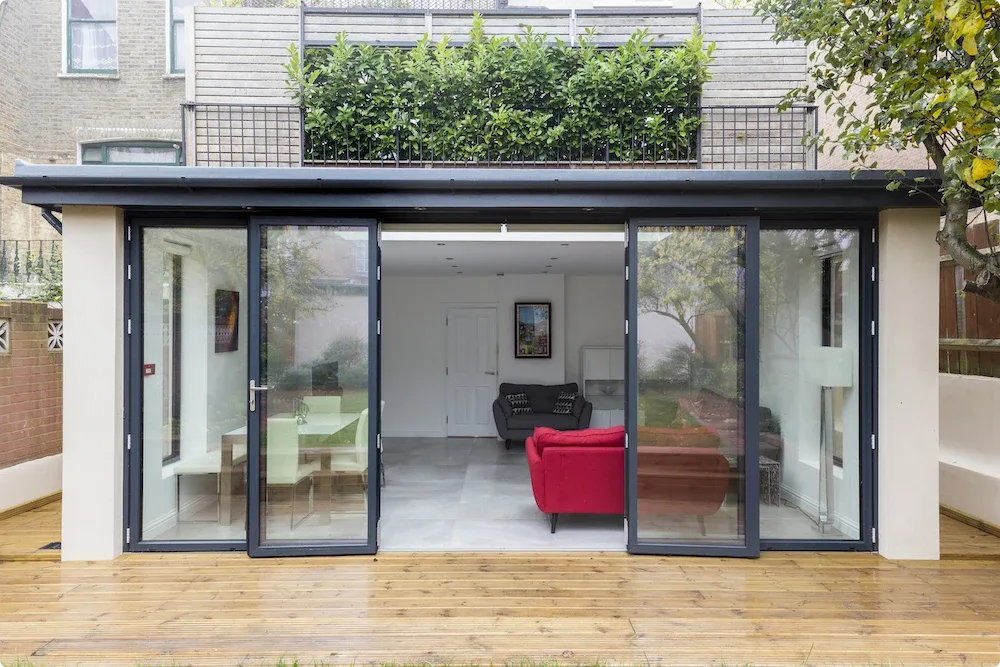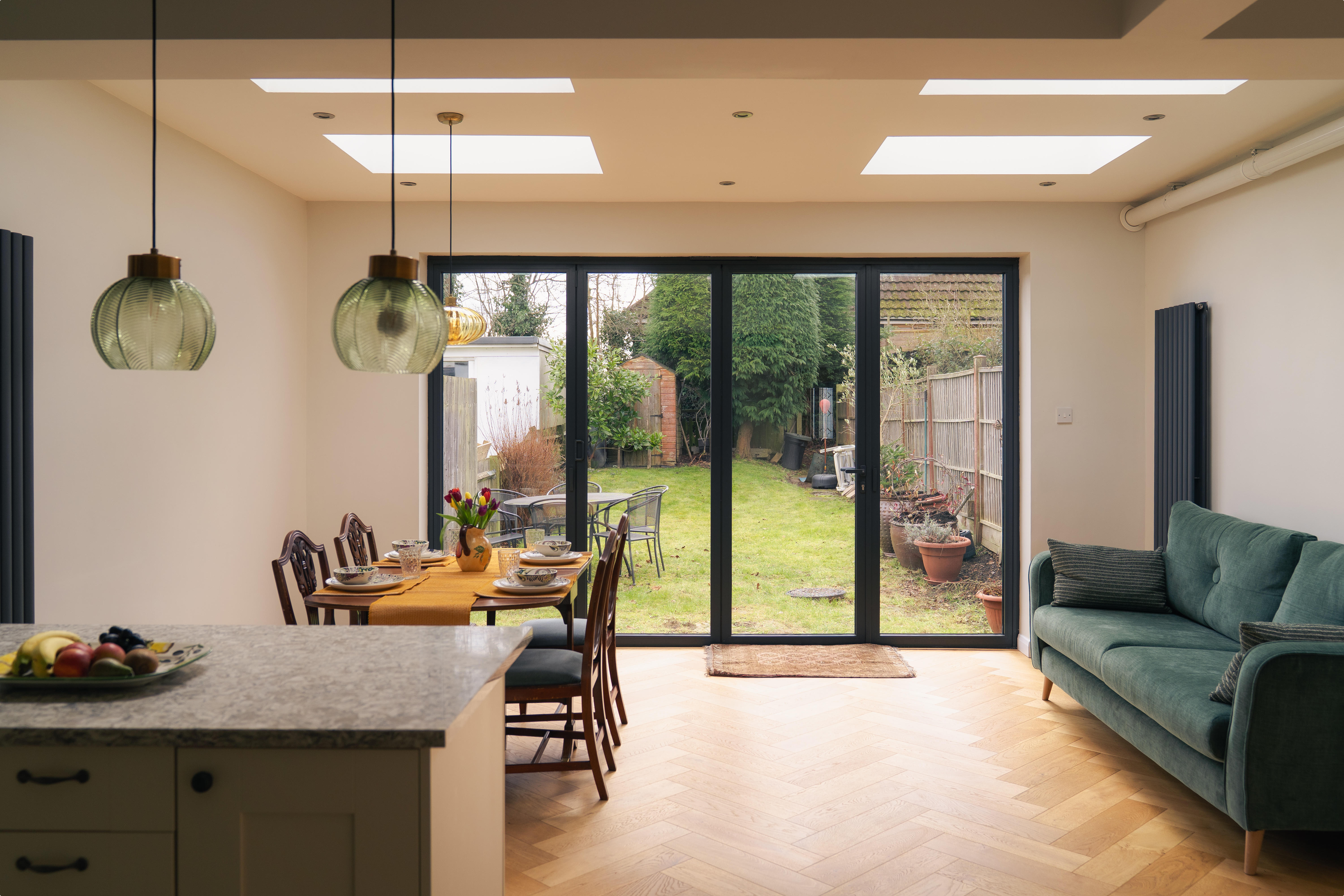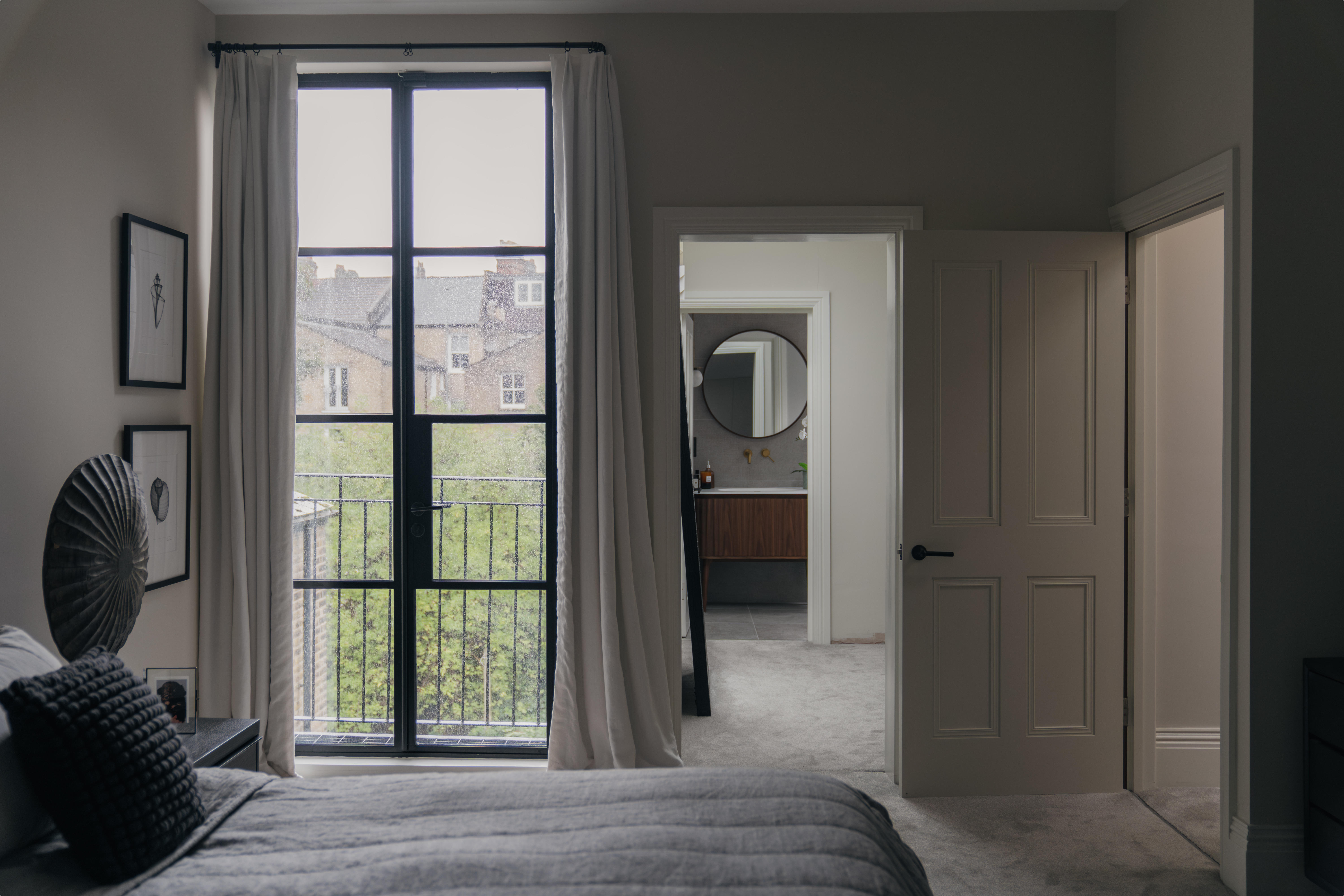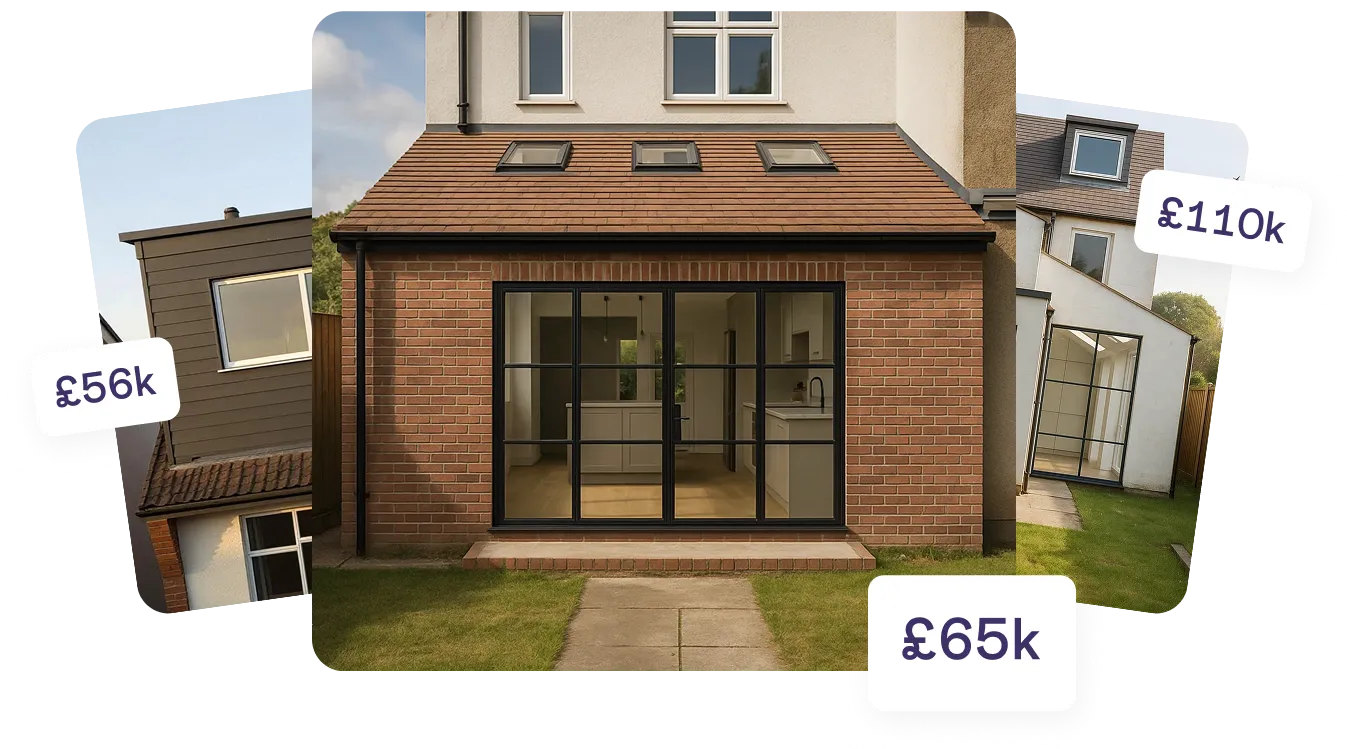How much does planning permission cost for an extension?
By now, you may well be clear on whether your home extension plans fall within a permitted development, or whether you need planning permission. But if you’re not, don’t panic. You can keep reading to understand the difference, or use our free tool to find out.
If it turns out you do need planning permission for your loft conversion, rear extension, or whatever else you’re hoping to build, costs will differ depending on where in the UK you live. These are the fees you’ll have to pay if you’re making a householder application to alter or enlarge an existing individual house (or a “single dwelling” as it’s called in the application):
It’s worth noting that if you’re looking to extend a flat or a maisonette, rather than a house, the same fees will apply. But rather than making a householder application, you’ll need to make a full application instead. You can read more on the different types of applications and what they mean below.
In England (but not Wales, Scotland, or Northern Ireland), the planning application fee is a little cheaper if you’re building something that’s not attached to your house, but falls within the boundary of your property. For example, it could be an outbuilding containing a gym, annexe, or office, that doesn’t fall within a permitted development. In that instance, the planning permission application costs £262. This fee would also cover planning permission for fences, gates, or walls along your boundary.

How much does planning permission cost for a new build?
If you’re building a house from scratch, you’ll need to make a full planning application rather than a householder application. This also varies depending on where in the UK your plot of land is, and the costs for permission to build a single house are:
- £588 in England
- £460 in Wales
- £691 in Scotland
- £1,035 in Northern Ireland
Cost of planning permission applications in the UK: A recap
|
Alterations/extensions |
Building a new home |
| England |
£528 |
£588 |
| Wales |
£230 |
£460 |
| Scotland |
£346 |
£691 |
| Northern Ireland |
£347 |
£1,035 |
Remember, planning application fees will continue to increase every year in line with inflation. These are the most recent figures as of 1 April, 2025.
Which type of planning application do you need to make?
It’s easy to get lost in research about the different types of planning applications, so let’s simplify it with the help of Resi’s planning experts.
“The type of application you'll need depends on your property type,” explains Resi’s Senior Planning Consultant, Danielle Price. “If you live in a single house (which is classified as one residential unit), you can apply for a householder application. For any other property type, such as a flat or maisonette, you'll need to submit a full application.”
When building a new house from scratch, you’ll need to make a full planning application. For this, you’ll need detailed architectural drawings and site plans of the proposed development, which is why some developers decide to get outline planning permission before all that.
Outline permission is sort of like an ‘in principle’ planning permission. It’s usually used on bigger projects to give the developer an idea of what might be possible for the build, before an architect is brought in to figure out the details. But it’s important to note that you can’t start construction based on outline permission alone — you’d need to get full planning permission for that.
Outline application fees are a bit more complex, because they depend on the size of the site area that’s being built on. But for a rough idea, costs start at £588 for each 0.1 hectare of land in England.
Do you need planning permission?
Now you know how much planning permission costs, it’s back to the big question, because it can be confusing: Do you need planning permission for your proposed project? Or do you benefit from having permitted development rights?
You can use our free online tool to figure out your situation. But in a nutshell: Permitted development rights are part of a government scheme that allows homeowners to extend their homes without the need for planning permission. However, there are strict rules about what kind of adaptations fall within these permitted development rights.
The rules largely focus on the size of the extension (for example, it can’t take up more than 50% of the land around the original house). But there are some other factors involved that can make it more complicated, such as whether your home is a listed building, or if it sits in a conservation area.

“If you're unsure whether your home extension needs planning permission, we recommend reaching out to a planning consultant or architect like Resi before submitting your application,” says Danielle. “The conditions within permitted development rights can be complex, making it easy to misinterpret the requirements.” You can schedule a free, no-obligation 30-minute consultation with Resi’s expert consultants for some tailored advice.
If it turns out that your extension can be done as part of a permitted development, you could decide to apply for a Certificate of Lawful Development. “This formal application confirms whether your proposed work counts as permitted development, giving you certainty about whether planning permission is needed,” explains Danielle.
“If granted, you'll have official confirmation that planning permission isn't needed. If refused, you'll know to apply for planning permission.” This can also be a useful document to have in the event that planning policies change later down the line, as it proves that your project was legal at the time of construction.
Lawful development certificates for a proposed use or operation cost half the full application fee in England (£264), while they're £346 in Scotland and £230 in Wales.
How do you apply for planning permission?
Planning permission applications are made to your local planning authority, but there’s a central platform called the Planning Portal to help streamline the process. It’s important to note that the Planning Portal charges an administration fee of £85 on top of the planning permission fee, so you should factor this into your costs.
Whether your project needs planning permission or falls under permitted development, Resi’s experts (which include ex-council planning officers), will manage your application via the Planning Portal and will work with the local authority on your behalf to arrive at an outcome. The target timeline for a decision on a planning application is 8 weeks, but councils aren’t held by that deadline. After working on almost 10,000 house extensions, Resi has access to unique data on how long planning permission usually takes to be granted in each local authority. You can check the average timeframe for your council to process planning applications here.
“At Resi, we have live data that updates with each decision we receive from local authorities, giving a more accurate picture of application timescales,” says Danielle. “This means we're able to advise at the start of your project if your specific council is experiencing department-wide delays.”
If your planning permission application is rejected, do you have to pay again to reapply?
Holding out for a decision on your planning application can be a tense wait. So what happens if it gets rejected?
“You can appeal the council's refusal,” explains Danielle. “An appeal has no application fee, but you may incur costs elsewhere if you instruct a professional to help you with the application.”
On the other hand, if your application is refused, you can make the necessary adjustments to your plans and reapply. “There’s no limit on how many planning applications you can submit, though each new application requires the full fees to be paid again,” Danielle advises.
According to Danielle, some of the most common reasons residential planning permission applications are rejected include:
Design and heritage: Scale, bulk, massing, impact on street scene, being out of character, listed status
Impact on neighbours: Overlooking/loss of privacy, overshadowing, overbearing/loss of outlook
Technical: Flood risk, impact on trees, effect on wildlife e.g. bats, traffic and parking, being in a green belt, previous applications and conditions

How can you give yourself the best chance of getting planning permission approved?
As we’ve seen, planning application fees aren’t exactly cheap. So it’s natural to want to hit the bullseye and get your planning permission application approved first time. Resi’s Senior Planning Consultant Danielle has some useful advice to improve your chances:
Use a consultant
“Working with a planning consultant genuinely makes a difference,” says Danielle. “While it shouldn't be necessary, the planning system can be incredibly confusing and frustrating unless you understand its intricacies.”
“A consultant with experience working both for councils and submitting applications to them takes all the stress out of the process. We handle unexpected challenges, maintain communication with case officers, and manage all the administrative requirements to help you achieve a positive outcome more quickly.” Read more about how Resi can help you with the design and planning process.
Be realistic
Listen to professional advice and try to maintain realistic expectations about what likely can and can’t be achieved. “We're not here to stifle creativity or stop you from designing an attractive addition to your home,” says Danielle. “Rather, we're here to ensure your creative vision translates into something your builder can actually construct, rather than remaining forever on your architect's drawings.”
Understanding planning advice and making informed decisions based on risk assessment is vital for maximising your chances of success and the speed of approval, and Resi’s experts can help you join those dots.
Get your priorities straight
It's essential to clearly understand your priorities before beginning the process. “If speed and budget are your main concerns, you'll want to minimise project risks, which might mean being conservative and using your permitted development rights,” explains Danielle. “However, if maximising space and creative design are your priorities, and you're less concerned about budget and timeline, you might choose to go for a more ambitious planning application.”
As part of figuring out your priorities, Danielle says it's crucial to understand your bottom lines. “Before entering the planning process, know what compromises you might need to make to get your application approved — whether you're willing to adjust roof pitch, extension materials, or other design elements.”
Speak to your neighbours
“We strongly recommend speaking to your neighbours as early as possible in the process, particularly if you're doing a larger home extension,” advises Danielle. “Getting your neighbours on board can not only make the planning process smoother by avoiding objections and delays, but early engagement also helps ensure that other technical requirements, such as party wall agreements, proceed more smoothly.” Time to go knocking with a bottle of wine?







